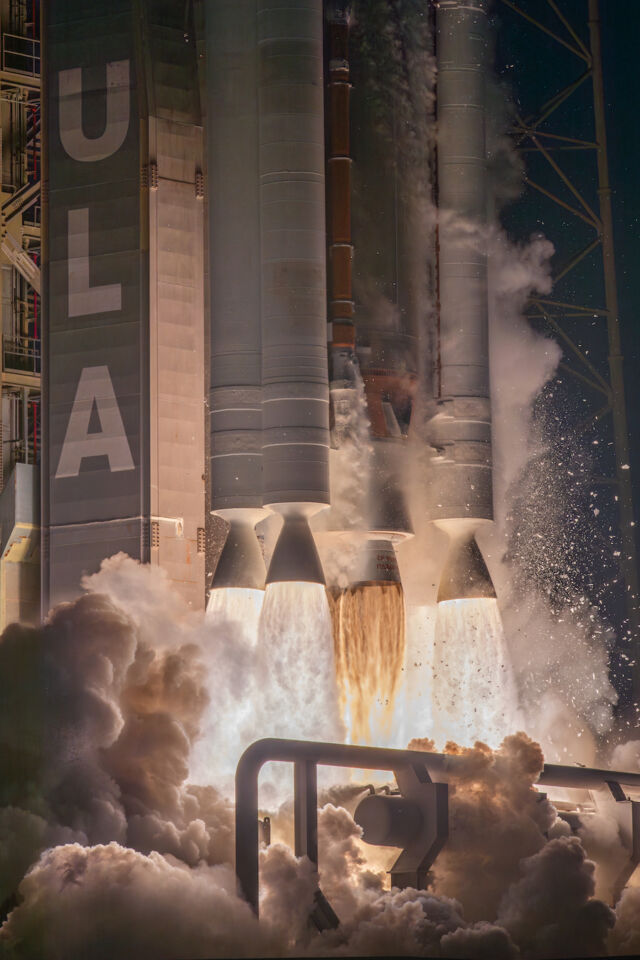With a landmark launch, the Pentagon is finally free of Russian rocket engines

United Launch Alliance delivered a classified US military payload to orbit Tuesday for the last time with an Atlas V rocket, ending the Pentagon’s use of Russian rocket engines as national security missions transition to all-American launchers.
The Atlas V rocket lifted off from Cape Canaveral Space Force Station in Florida at 6:45 am EDT (10:45 UTC) Tuesday, propelled by a Russian-made RD-180 engine and five strap-on solid-fueled boosters in its most powerful configuration. This was the 101st launch of an Atlas V rocket since its debut in 2002, and the 58th and final Atlas V mission with a US national security payload since 2007.
The US Space Force’s Space Systems Command confirmed a successful conclusion to the mission, code-named USSF-51, on Tuesday afternoon. The rocket’s Centaur upper stage released the top secret USSF-51 payload about seven hours after liftoff, likely in a high-altitude geostationary orbit over the equator. The military did not publicize the exact specifications of the rocket’s target orbit.
“What a fantastic launch and a fitting conclusion for our last national security space Atlas V (launch),” said Walt Lauderdale, USSF-51 mission director at Space Systems Command, in a post-launch press release. “When we look back at how well Atlas V met our needs since our first launch in 2007, it illustrates the hard work and dedication from our nation’s industrial base. Together, we made it happen, and because of teams like this, we have the most successful and thriving launch industry in the world, bar none.”
RD-180’s long goodbye
The launch Tuesday morning was the end of an era born in the 1990s when US government policy allowed Lockheed Martin, the original developer of the Atlas V, to use Russian rocket engines during its first stage. There was a widespread sentiment in the first decade after the fall of the Soviet Union that the United States and other Western nations should partner with Russia to keep the country’s aerospace workers employed and prevent “rogue states” like Iran or North Korea from hiring them.
At the time, the Pentagon was procuring new rockets to replace legacy versions of the Atlas, Delta, and Titan rocket families, which had been in service since the late 1950s or early 1960s.

Ultimately, the Air Force chose Lockheed Martin’s Atlas V and Boeing’s Delta IV rocket for development in 1998. The Atlas V, with its Russian main engine, was somewhat less expensive than the Delta IV and the more successful of the two designs. After Tuesday’s launch, 15 more Atlas V rockets are booked to fly payloads for commercial customers and NASA, mainly for Amazon’s Kuiper network and Boeing’s Starliner crew spacecraft. The 45th and final Delta IV launch occurred in April.
Boeing and Lockheed Martin merged their rocket divisions in 2006 to form a 50-50 joint venture named United Launch Alliance, which became the sole contractor certified to carry large US military satellites to orbit until SpaceX started launching national security missions in 2018.
SpaceX filed a lawsuit in 2014 to protest the Air Force’s decision to award ULA a multibillion-dollar sole-source contract for 36 Atlas V and Delta IV rocket booster cores. The litigation started soon after Russia’s military occupation and annexation of Crimea, which prompted US government sanctions on prominent Russian government officials, including Dmitry Rogozin, then Russia’s deputy prime minister and later the head of Russia’s space agency.
Rogozin, known for his bellicose but usually toothless rhetoric, threatened to halt exports of RD-180 engines for US military missions on the Atlas V. That didn’t happen until Russia finally stopped engine exports to the United States in 2022, following its full-scale invasion of Ukraine. At that point, ULA already had all the engines it needed to fly out all of its remaining Atlas V rockets. This export ban had a larger effect on Northrop Grumman’s Antares rocket, which also used Russian engines, forcing the development of a brand new first stage booster with US engines.
The SpaceX lawsuit, Russia’s initial military incursions into Ukraine in 2014, and the resulting sanctions marked the beginning of the end for the Atlas V rocket and ULA’s use of the Russian RD-180 engine. The dual-nozzle RD-180, made by a Russian company named NPO Energomash, consumes kerosene and liquid oxygen propellants and generates 860,000 pounds of thrust at full throttle.
Source link




